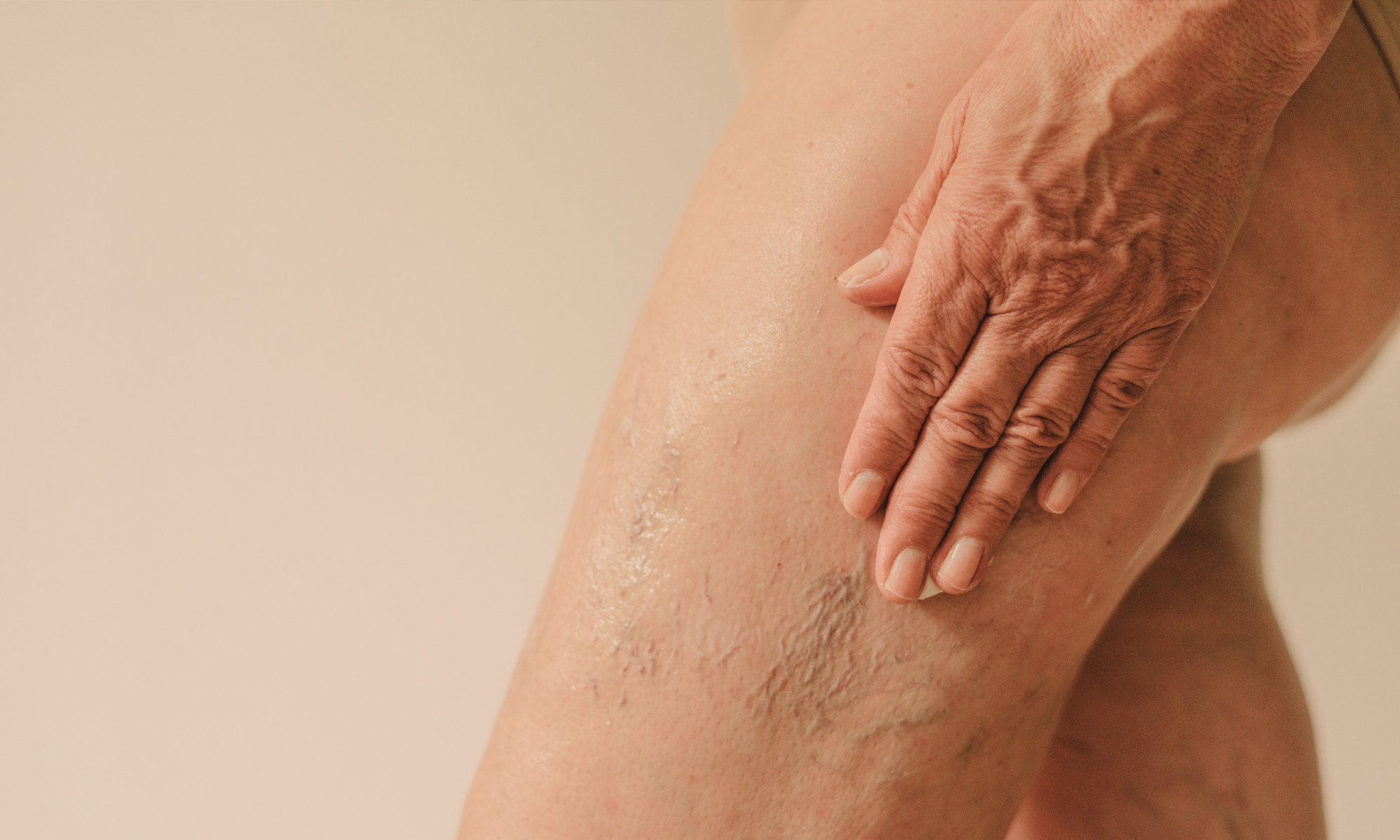How To Treat + Prevent Crepey Skin Anywhere On The Body
If you have wrinkles on the legs, it just might be crepey skin.


mbg Assistant Beauty Editor
mbg Assistant Beauty Editor
Hannah Frye is the Assistant Beauty Editor at mindbodygreen. She has a B.S. in journalism and a minor in women’s, gender, and queer studies from California Polytechnic State University, San Luis Obispo. Hannah has written across lifestyle sections including health, wellness, sustainability, personal development, and more.
Image by Eloisa Ramos / Stocksy November 6, 2022 Our editors have independently chosen the products listed on this page. If you purchase something mentioned in this article, we may Aging is a privilege, and just because a few wrinkles pop up over the years does not mean that fact should be overlooked. It’s easy to get caught up in how your skin should or shouldn’t look at a certain age, but as experts will tell you, there’s no hard and fast rule stating when skin aging is normal. That being said, it’s equally important to feel confident in how you look, for the sake of your mental health. So if crepey skin has you down, this might help you make sense of what’s going on and encourage firmer skin naturally. 
Advertisement
This ad is displayed using third party content and we do not control its accessibility features.
What is crepey skin?
You may have heard the term crepey skin before, but do you actually know what it is? If not, picture streamers that are strung around as birthday or celebration decor. They’re crinkly, thin, and wispy. There’s not much solid structure, which is why they’re so pliable and literally wave around in the wind.
This is where the term crepey comes from. Though your skin isn’t as thin as a streamer, similar wrinkles and lack of structure can occur, especially as you age. Besides being thin and wrinkly, crepey skin may also sag or feel loose, board-certified dermatologist Hadley King, M.D. tells mbg.
Can you get crepey skin on the legs?
Yes, you can certainly get crepey skin on your legs—though it’s important to first distinguish it from cellulite. “Cellulite occurs when fat deposits push through the connective tissue beneath the skin,” King says. This can appear dimply, rather than wrinkly.
“The exact cause of cellulite is unknown, but it appears to result from an interaction between the connective tissue in the layer that lies below the surface of the skin and the layer of fat that is just below it,” King explains.
Cellulite can be genetic, meaning you can have it no matter what you use on your skin, how old you are, and how much you weigh. A gentle reminder, cellulite is not a bad thing. While it’s completely normal to feel insecure about it—thanks to the unfortunately significant perfectionism culture around body image and photoshop—cellulite is extremely common, especially for women.
Now, on the other hand, crepey skin can be prevented to a certain extent with skin care. Like cellulite, there’s nothing wrong with having crepey skin, and everyone will get it eventually as it’s a natural part of skin aging. But if you want to delay the process, there are a few things you can do—more on that in a bit.
Advertisement
This ad is displayed using third party content and we do not control its accessibility features.
Other common places to get crepey skin.
Your skin can get crepey anywhere on the body, but thinner skin is more susceptible, including the eyelids, upper arms, neck, chest, under the eyes, and the tops of the hands. Because these areas are thinner, they might be more sensitive to harsher treatments like retinol or strong exfoliants, so tread lightly.
These are areas that are often exposed to the sun as well (particularly the neck, hands, and eyes), which can mean premature aging, as we'll get to in a second.
Causes of crepey skin.
There are a few specific factors things that can cause crepey skin, as King notes. These include:
Advertisement
This ad is displayed using third party content and we do not control its accessibility features.
All of these factors can contribute to crepey skin on the legs, but a few are more common in this area. For example, if you have crepey skin on your legs but nowhere else, you may want to think about the last time you applied SPF in the affected area.
Losing weight is also a frequent cause of crepey skin, so if you noticed particular slimming on your legs recently, then that could be why. The skin post-weight loss has been previously stretched, so it may be thinner once the fat underneath has decreased.
Smoking, diet, and exercise are all factors that contribute to general skin health, so it’s not surprising that they can lead to crepey skin. We’ll get into specifics next.
Crepey skin solutions & prevention.
Whether you’re looking to prevent or treat crepey skin, there’s a few different routes you can take—and you can certainly combine more than one for a multi-faceted approach.
Advertisement
This ad is displayed using third party content and we do not control its accessibility features.
If you’re not already using body lotion every day, you’ll want to consider adding it to your routine. “Moisturize moisturize moisturize,” King reiterates. You’ll want to find products that contain deeply hydrating ingredients as well as potent antioxidants.
If you want to skip the process of checking off all those boxes, the mbg postbiotic body lotion helps ease crepey skin with an antioxidant-packed formula that’s deeply hydrating yet nongreasy–reviewers echo its praise, too.
Advertisement
This ad is displayed using third party content and we do not control its accessibility features.
As you age, your body will pump the breaks on collagen production. In fact, research shows that your collagen levels begin to decline by 1% each year1, starting around your mid-20s. Once the degradation rate surpasses production, a lack of collagen may lead to sagging, crepey skin. For those who experience menopause, collagen decline picks up around that time as well.
So, you’ll want to replenish the lost collagen via nutrition. “Collagen-rich foods can significantly support skin hydration and elasticity," board-certified family physician and functional medicine expert Alejandra Carrasco, M.D. once told mbg.
And one of the best ways to internally support collagen production is through hydrolyzed collagen supplements. Research demonstrates that ingesting this form of collagen (and yes, only hydrolyzed peptides) can promote your natural collagen and elastin production1.
Not all collagen supplements use this form, so shop smart. Here’s a list of 9 clean and effective options, recommended by a nutrition Ph.D. to make your hunt easier.
Movement is beneficial to your health for so many reasons. If you are able, you should prioritize exercise in a way that works for your body and life. Perhaps it's not the primary benefit of working out, but it is worth noting that it may even help with crepey skin for a few different reasons.
First off, exercise can relieve stress which is just one of the many things that can lead to decreased collagen production and accelerated skin aging. Plus, exercise increases the delivery of nutrients to your skin’s cells and helps your body produce collagen which, as you just read, will help ease crepey skin.
This is not to imply that once you add in a workout class into your schedule, crepey skin will magically disappear overnight. (That's not how skin health works.) However, moving your body regularly can have significant downstream affects, including the appearance of your skin.
Using both chemical and physical exfoliants is great for crepey skin, especially on the legs. “AHAs dissolve the bonds that hold dull, dead skin cells on the surface of the skin so the skin will gently shed, revealing smoother, brighter skin underneath,” King says.
Glycolic acid, a popular AHA, is one of King’s top choices for this purpose. “Studies have shown, for example, that six months of topical glycolic acid stimulated a 27% increase in epidermal thickness2,” she notes.
If chemical exfoliating isn’t your thing, using a dry brush or a body scrub are both great options for physically exfoliating the arms and legs.
5.
Use a retinol body lotion.
Sun damage is the cause of about 80% of visible signs of skin aging4—and skipping SPF won’t help. Even though it may sound over-the-top, you should be applying sunscreen on every part of your skin that sees the sun—legs included.
There are several in-office procedures and treatments that can benefit crepey skin, no matter where you get it on your body. If you have the means and interest in getting non- or minimally-invasive producers (they're not for everyone!), your dermatologist will be the best person to assess what option(s) are best for you. Common recommendations are a fractional laser treatments, ultrasound therapy, and even filler. Again, these options are not for everyone, however they do exist if they pique your interest.
The takeaway.
Crepey skin occurs naturally with age, but it can be delayed and treated with topical retinol, exfoliants, and hydration. Internally supporting your collagen production will also encourage tighter, more firm skin. If you’re more concerned with wrinkling on the face, check out this expert-approved routine.

 AbJimroe
AbJimroe -v1646695196476.jpg?1148x800)
































